Extreme Review DESTEN Cyberbook U872

At the end of last year, the Intel Mobile Summit took place, at which the company spoke about its plans for the near future. At the meeting there were a lot of partners who presented their new products to the public. One of the partners was the company DESTEN , which announced its “not killed” laptops - they promised moisture and dust resistance, shock resistance and other bonuses. Usually I am skeptical about such statements until I personally make sure of everything ... so I got up and asked a company representative to do a crash test on one of the laptops, with all the results published - whatever they were.
Apparently, the company was so confident in their devices that without hesitation they agreed to my proposal. He took the laptop for the winter holidays - it was interesting not only to check all the declared properties, but also just to see how things were going with notebooks from other companies ... so to speak, for a change)
Unfortunately, the laptop was taken "naked", that is, without a box and other instructions - only the device itself and the network adapter. Therefore, I cannot say that it is included in the package ... and I immediately propose to proceed to the review. Meet - DESTEN CyberBook U872 .
')
Appearance
The cover of the laptop is completely made of metal, the thickness of which, it seemed to me, is not less than a millimeter. Small embossed "blotches", matte color - all neat. All corners have massive rubber inserts to cushion the potential impact of a fall.

An important detail - in the corners of the lid are special metal protrusions that greatly increase the "scratch resistance" of the laptop - its body simply will not come into contact with the unevenness of the surface on which it lies. A simple analogy is that it is much easier to damage the bottom of a sports car than a car with good ground clearance.

A little bit about the connectors. On the right is a solid cover behind which there are two USB connectors and a COM port; Looking ahead, all of these connectors are part of a removable module that plugs into an external Mini Card slot (Mini PCI), which means that the functionality of a laptop can be enhanced if desired.

 Clickable
Clickable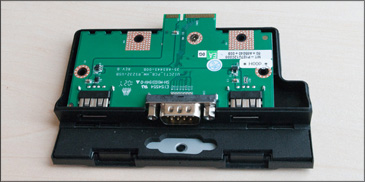
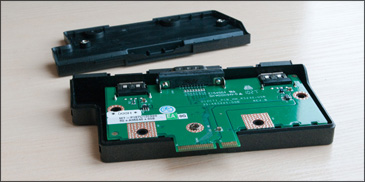
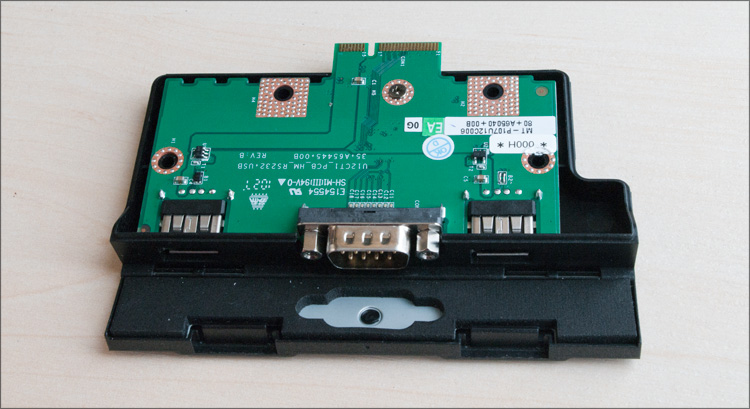
| PCI Express Mini Card (aka Mini PCI Express, Mini PCIe and Mini PCI-E) is a replacement for the Mini PCI form factor. On the Mini Card connector bus: PCIe x1, USB 2.0 and SMBus. For this connector standard, a mass of peripheral devices are available: WiFi modules, WiMax cards, GSM modems, GPS receivers, and even SSD drives. There are leads for indicator LEDs, for connecting SIM-cards (for GSM WCDMA); there are reserved pins for future devices. Power supply 1.5 V and 3.3 V. |
 Clickable
Clickable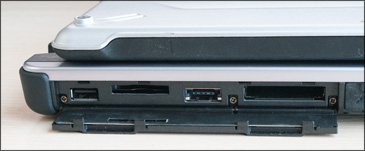
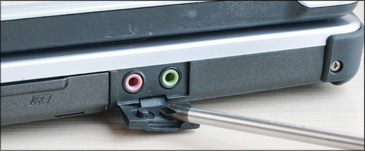
And very close is a rubber plug, behind which are hidden two audio jacks - for headphones and a microphone. Behind there are also two plugs. Behind the rubber - network connector for charging the laptop; for metal - VGA and network RJ45.

All metal covers open quite difficult - obviously not for gentle female handles.

So that the laptop does not accidentally open, there is a reliable metal lock on the front end - something like on suitcases)
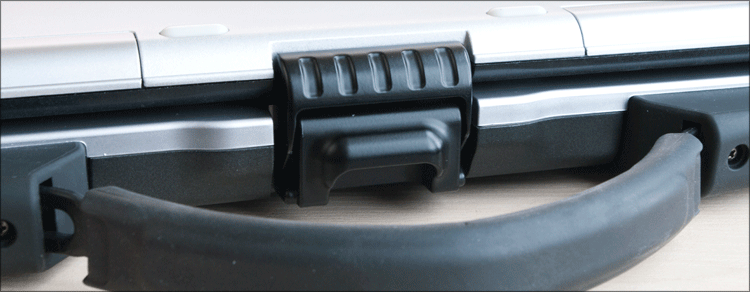
There is also a rubberized handle - well, just like a suitcase! It is flexible and, with its movable mechanism, goes to the rubber base of the butt.

On the back of the laptop there are several removable covers - it is even interesting what is behind each of them.
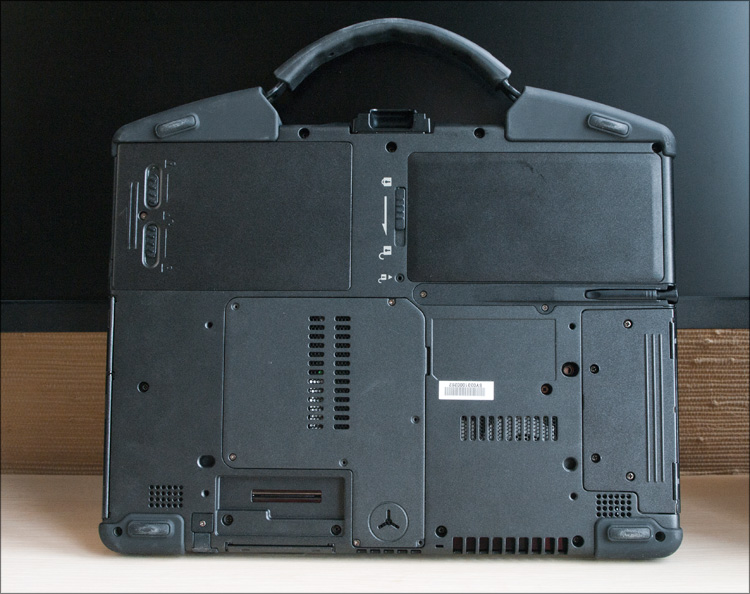
For the one that was on simple latches - the battery (Li-Ion, 11.1V, 5.2A, 57Wh, model U12C).

Another one is a hard disk (the usual Western Digital is 250 GB; strange, but there were no protective means on the disk, except a few rubber pads in the mounts).
 Clickable
Clickable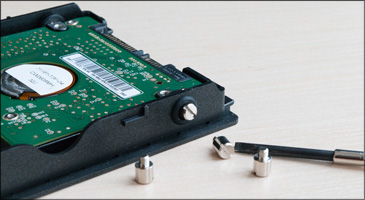
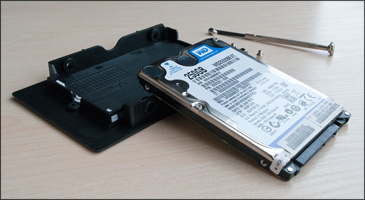
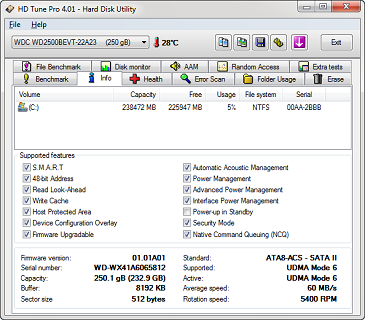

For the remaining and largest cover was the most interesting - that is why I decided to leave it for the last. So, two strips of RAM, or rather only one (2 GB) - the second can be set if desired.
 Clickable
Clickable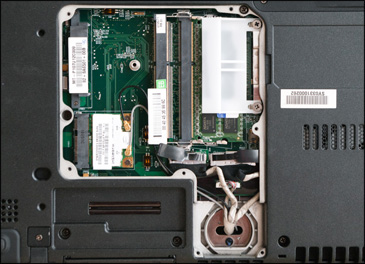
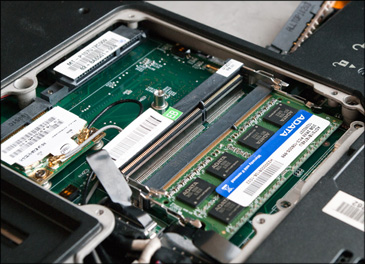
Next - a small Intel module, from which it took two wires; Of course, these are wires to an external antenna, but for the sake of interest, I still unscrew it.
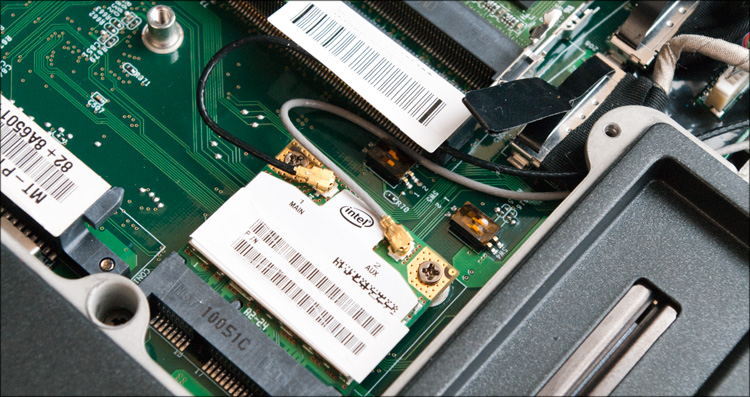
It turned out that this is Intel WiFi Link 1000 ( PDF ) and it is inserted into the same Mini Card slot, so there are already two such slots in the system.
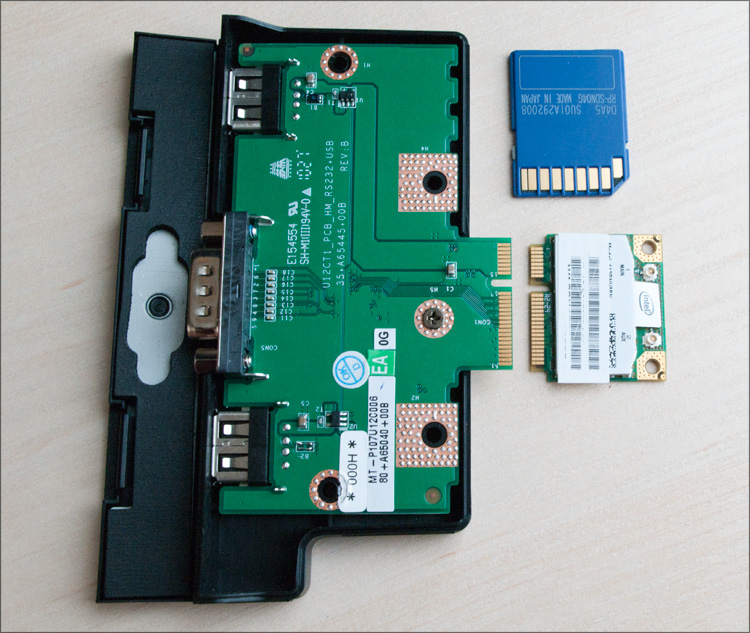
Not less than I was surprised by the SATA connector and the power connector for connecting another disk - I don’t know how to fit it there (except 1.8 ”, and that would hardly fit).

Well, right there - wires and cables that go somewhere on the screen ... more on that later.
There is also a connector near this cover, very similar to the docking connector. But I did not find any information on this issue.
The last "interesting" element on the bottom is a sticking "ass" of the stylus, which for some reason sometimes falls out)
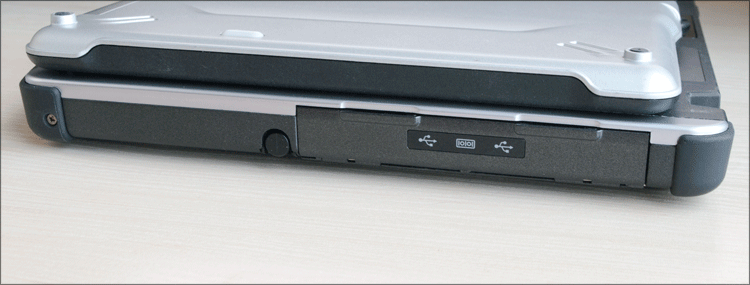
Despite the bottom rich in the number of elements, in general it is even and looks quite homogeneous.

The bottom is also metal (made of magnesium alloy), there are 4 rubber legs on it - again, so that the surfaces do not touch, and additional ventilation could be carried out in the gap.
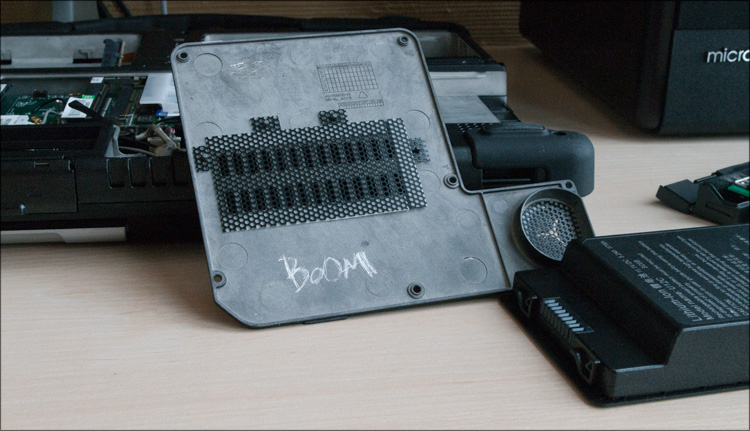
The only thing that seemed illogical to me was that in the closed state there is a small gap between the keyboard and the screen; on the contrary, everything should be sealed. All the bottom is also metallic:
The screen is quite thick and leans back 180 degrees, which is not so common in laptops. Moreover, the screen is rotatable (also 180 degrees, only clockwise) and allows you to turn the laptop into a tablet - for structural strength, you can again use the lock under the handle.

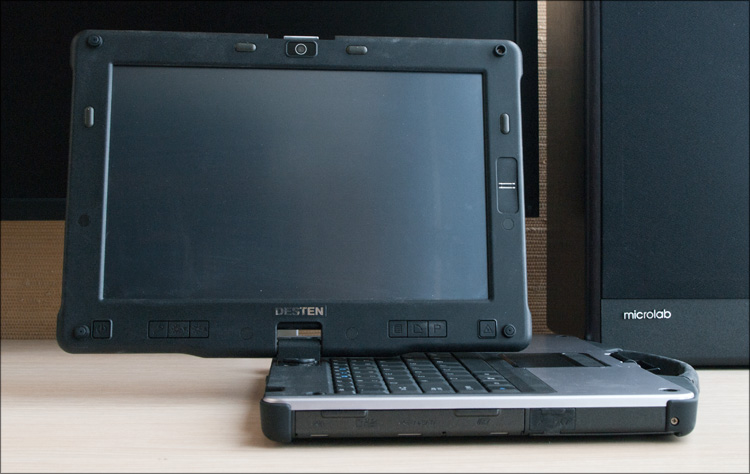
But even in this case, the manufacturer thought about the safety of the device - in the corners of the screen are all the same protrusions that will save the matrix when falling "flat."
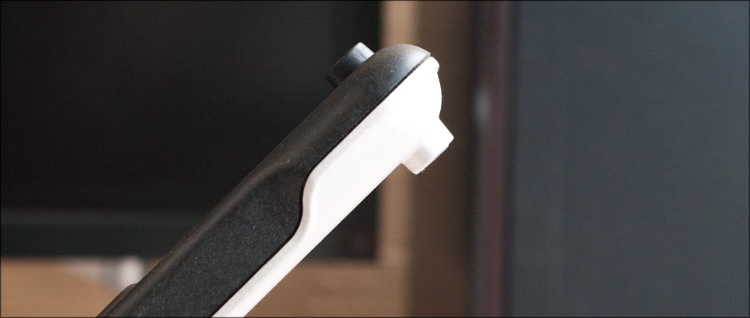
The rotary mechanism is metallic and, at first glance, quite reliable. The screen keeps perfectly in any position in which you put it.
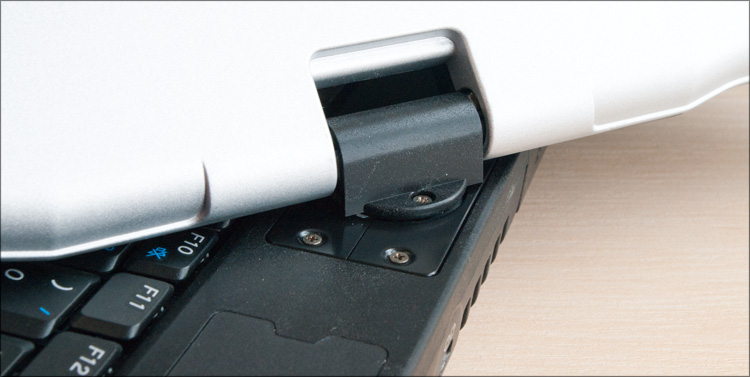
The frame around the screen is matte and thick. Top - a webcam, right - waterproof fingerprint scanner.
Below - 8 buttons, the functions of some of which I did not recognize. From recognized - the power button, microphone and display brightness control. Another one completely (all) switches on the entire backlight - the screen, the LEDs, etc. ... while the laptop continues to work - it is not clear what this is for.

I forgot the most important thing - the screen itself is matte and moreover, the touch screen! Not for nothing did they make a convenient stylus and the ability to form a tablet! :)
 Clickable
Clickable

Keyboard, as it is supposed to devices with a similar screen diagonal, without a digital block. The buttons are square, with bevels; Cyrillic on this sample was not. I didn’t like the fact that FN on the left is to the left of the CTRL key, that Windows users tear all templates. The keyboard is waterproof.
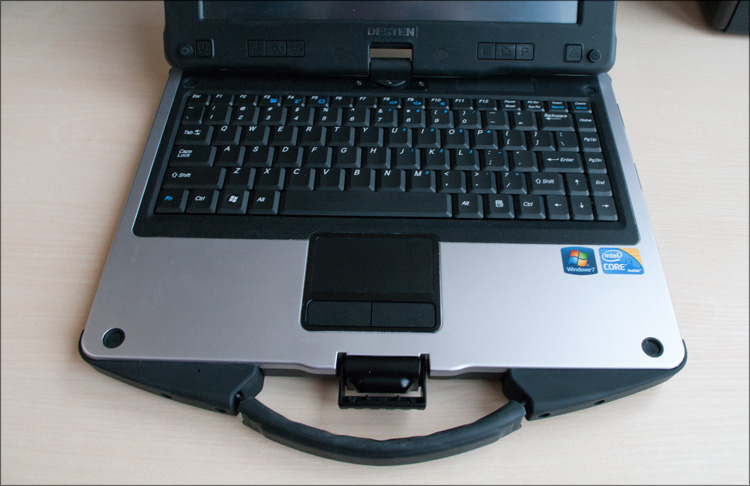
Below is the touchpad, which also has moisture-proof properties. It is relatively small, tactilely pleasant, it even had a place for the scroll area. Below are two keys. In the corners of the space around the touchpad there are two indentations - for those projections that are on the opposite side of the device.

Turn on and work
After pressing the main button, the LEDs light up under the screen, which I did not even notice at first. During boot, the laptop offers to enter the BIOS by pressing the F2 key. For the sake of I go; The first page provides information about the system - inside a dual-core Intel Core i3-330M processor and 2 GB of memory. You can also turn on the Bluetooth, WLAN, WWAN and GPS modules in (s); otherwise everything is more or less standard.
 Clickable
Clickable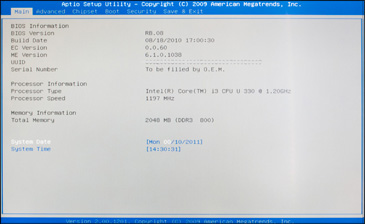
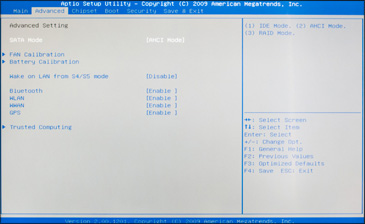
Although I was surprised by the presence of two functions that I meet in laptops for the first time. Fan calibration - this procedure takes about three minutes and during operation displays information about the various operating modes of the system cooler. How is it useful? Firstly, I was able to immediately estimate the maximum noise level from it - it is quite low. But secondly, it seems to me, it can help to diagnose the cooler, if something suddenly happens to it. There is also a function Battery calibration , which, as I understand it, is needed when using the device for the first time - it first completely discharges the battery and then charges it.

The full load time of Windows 7 on the laptop is about 30 seconds. Unfortunately, there were no non-standard applications (except for Microsoft Security Essentials and the Protector Suite utility) - it looks like someone just installed the bare OS in advance. I wanted to download something from the manufacturer’s website, but I didn’t even find a page for downloading drivers.
The display is bright and even behaves quite well in the sun, but the viewing angles are not the best. The stylus pen begins to influence the cursor from a height of about a centimeter; very convenient form of the stylus.
The screen is resistive and has good sensory properties, but the resistive coating layer itself under the working surface has irregularities along the edges. In particular, at the most extreme points (where hardly anyone will reap) the pen does not work - for the sake of completeness, I made a screenshot in the diagnostic program, where everything is clearly visible.
 Clickable
Clickable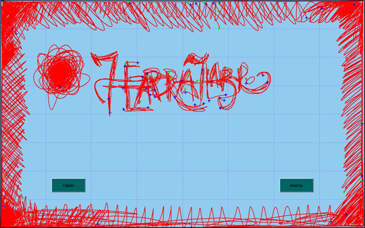
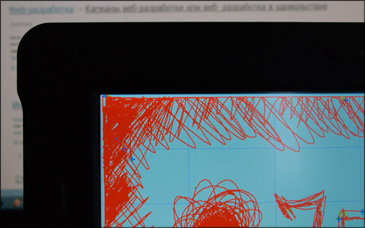
The operating time in the combined mode (a little wifi, medium intensity backlight) is about 4 hours, which is quite good ... on the other hand, there is an Intel Core i3 processor without discrete graphics, so I would like more impressive numbers. During operation, the laptop is almost not heated.
 Clickable
Clickable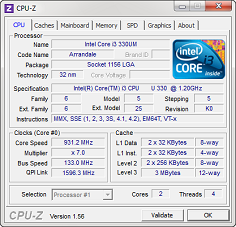
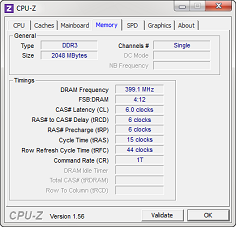
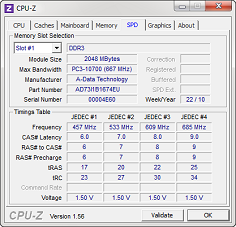
Crush test
Nothing lasts forever and this saying goes perfectly with laptops. Some laptops can break even with normal use, not to mention deliberately disabling - there are a thousand and one ways to break a laptop in an instant. But at once I want to warn the bloodthirsty readers - in this case we set ourselves the task of checking the laptop for survivability, and not “somehow more elegantly smash everything into chips.”
 Water
WaterThis was the first thing I checked out.

In general, it was somewhat unusual to pour water into a laptop - stereotypes and all things ... nevertheless, I took a towel, 4 supports and several cups of water. We watered plentifully - the keyboard and touchpad itself ... everything is without problems - the water just flows through the drain hole, and with a large number of it - also through the edges. The screen and fingerprint scanner also have waterproof properties.
 Clickable
Clickable

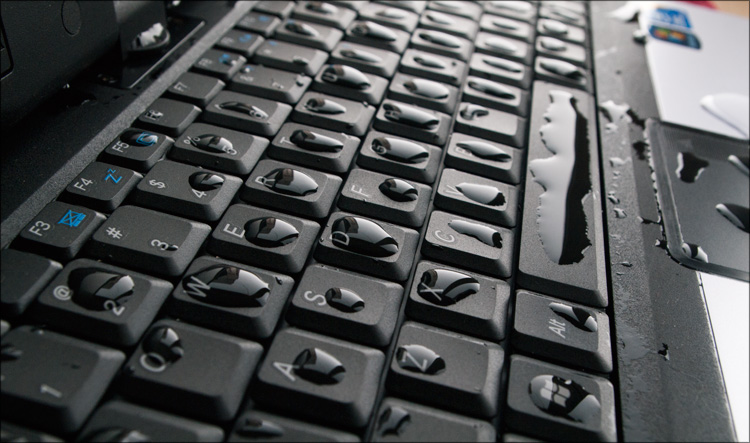
 Dirt and dust
Dirt and dustIt was not so easy to find the dust in winter, and in general I didn’t want to mess around ... but we rolled quite a bit in the dirt and snow of the laptop. They threw snowballs at the laptop, dug them into the car - with a shovel, of course, it is more convenient, but if it is not there, then this laptop will not leave the owner in trouble;)

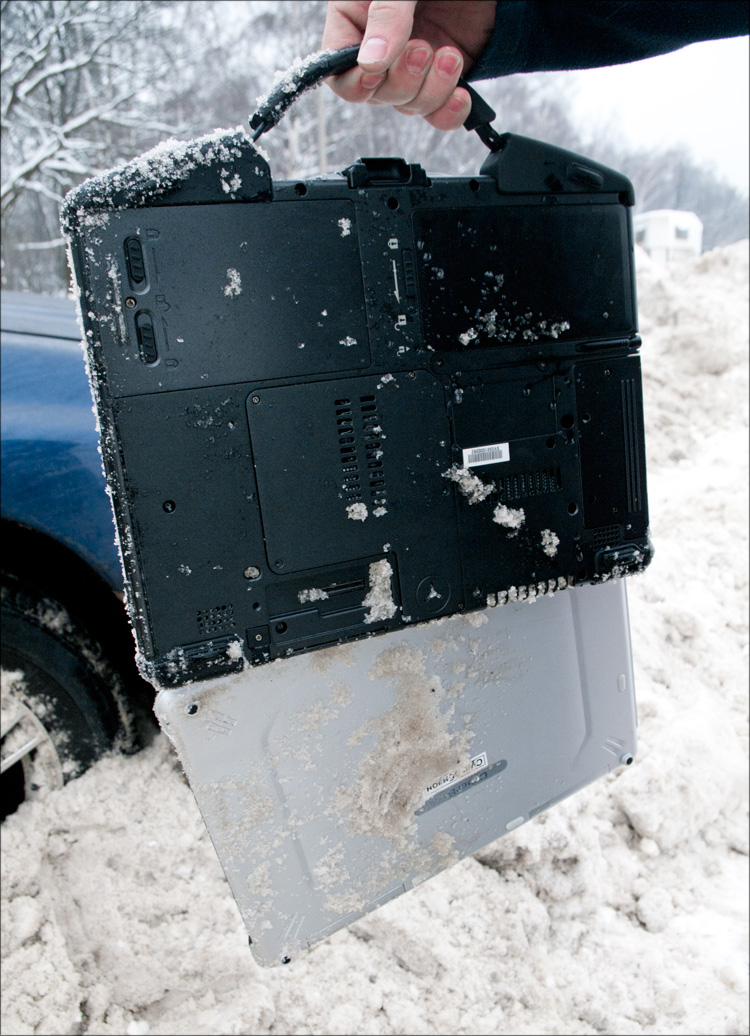
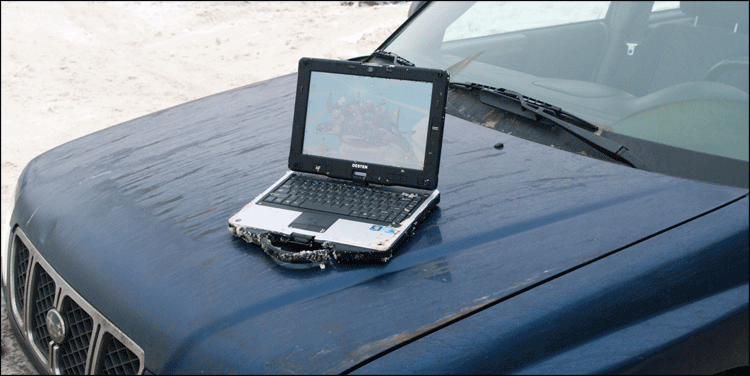
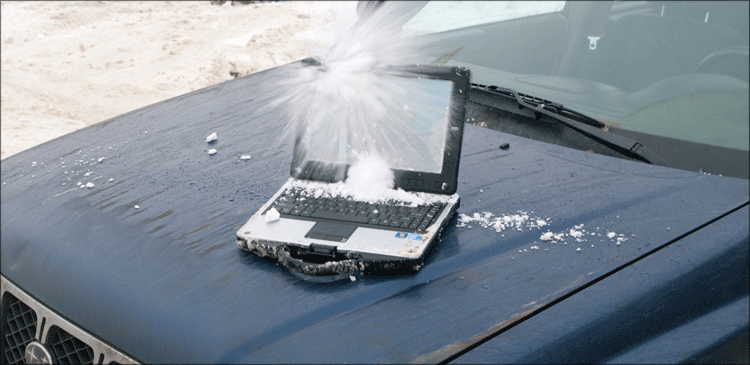
Please note that from two snowballs the opening angle of the lid almost did not change.
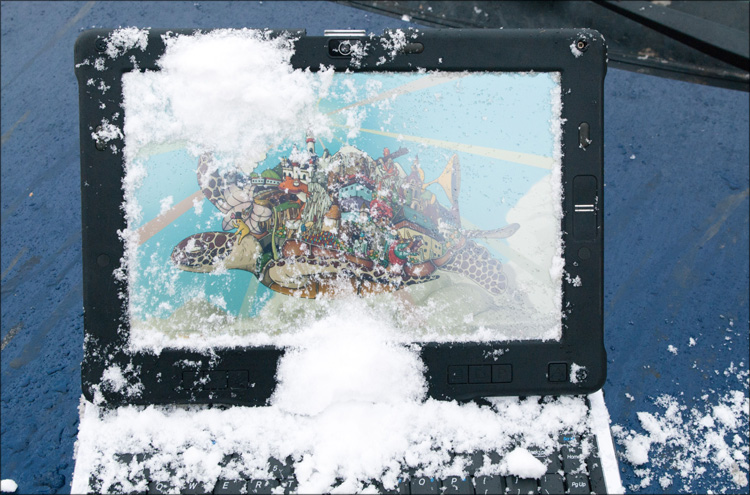
 Falls and vibrations
Falls and vibrationsI didn’t find any overly innovative systems in the field of hard disk protection - I dare to assume that everything is based solely on rubber tabs around the disk and on ShockGuard technology in the drive itself from WD. Nevertheless, the laptop withstood about 10 drops from a meter height - each time it was in working condition and in half of the cases it was in the open state - nothing terrible happened, it worked, and it continued to work; a couple of times the lid turned inside out somehow, but not to the detriment of the hinge.

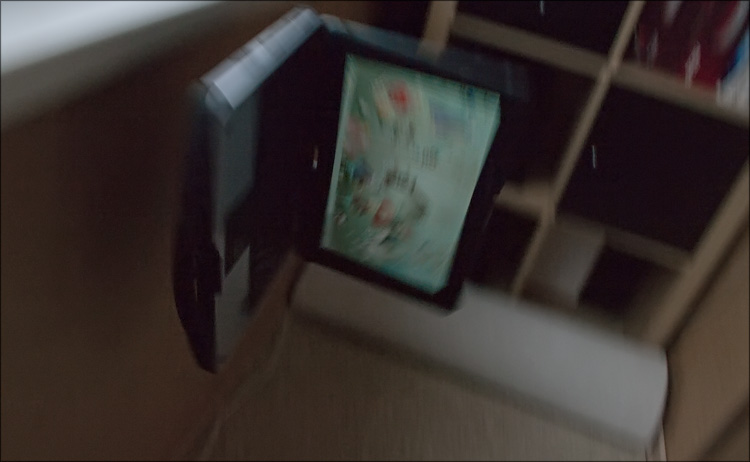
From one of the falls, my heart was bleeding from the very heart - it was about two meters high, and below was a concrete slab. The laptop fell very badly - the hinge on the metal "ear" plate ... only after this fall on the laptop the first wound formed - a small dent on the metal case, but the device continued to work. There were no bad sectors on the disk, although I suspect that all of this did not go to his advantage :)
 Pressure
PressureI decided to take the laptop with me when my friends and I went to ride a buggy. About an hour on the circuit of the autodrome lay a foreign body, according to which small funny cars drifted) But then I agree that this test is not terrible - the mass per unit area is quite small (and even a laptop in the snow), and the interaction time is even less .
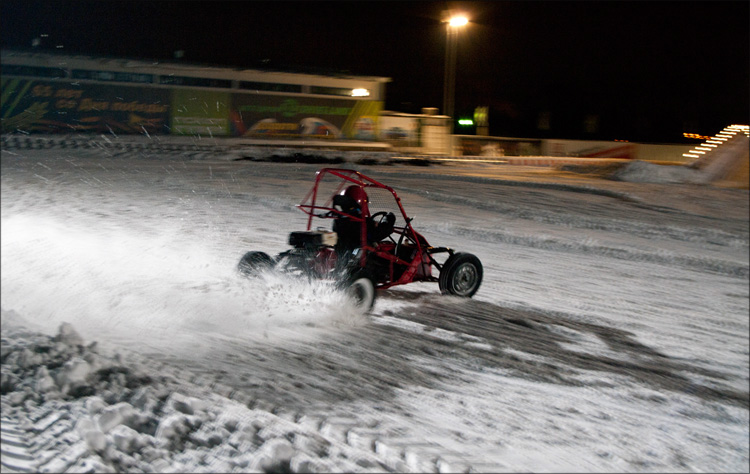
Later on the laptop got 70 pound buddy. Including one foot (the smallest area) to the center of the display lid (where to push the case is easiest) - without complications.
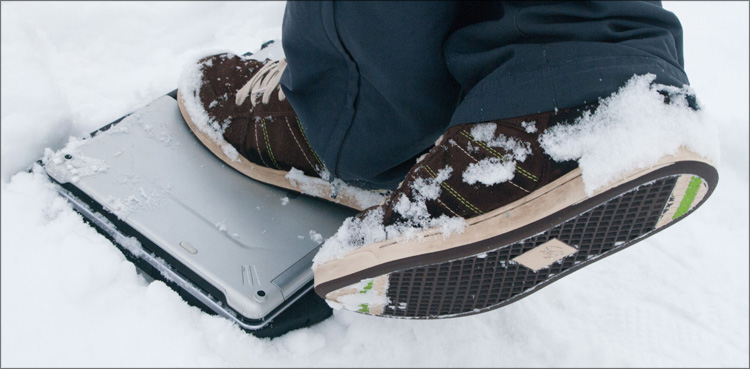
I dare to assume that nothing would have happened under an ordinary car with a laptop ... However, we chose a milder instrument of torture;)


 Scratch resistant
Scratch resistantThis parameter, though not stated by the manufacturer, but he surprised me. Agree, it is unpleasant, when from any light source the cover of an ordinary laptop literally overflows with all sorts of small scratches? There will be no such thing.


The claws of the kindest dog in the world left no traces on the lid. A half-hour journey of the laptop (in the open state) in the trunk of the car, among the shovels and tool boxes ... easy!
 Clickable
Clickable

When the girl was traveling on a laptop from an icy hill, I was afraid that the laptop would be exactly the same as after the bombing ... but no - after five such trips there were no scratches at all! And the point here is not so much in some kind of secret coverage, but in the thoughtfulness of the structure, or rather, in those very projections in the corners.
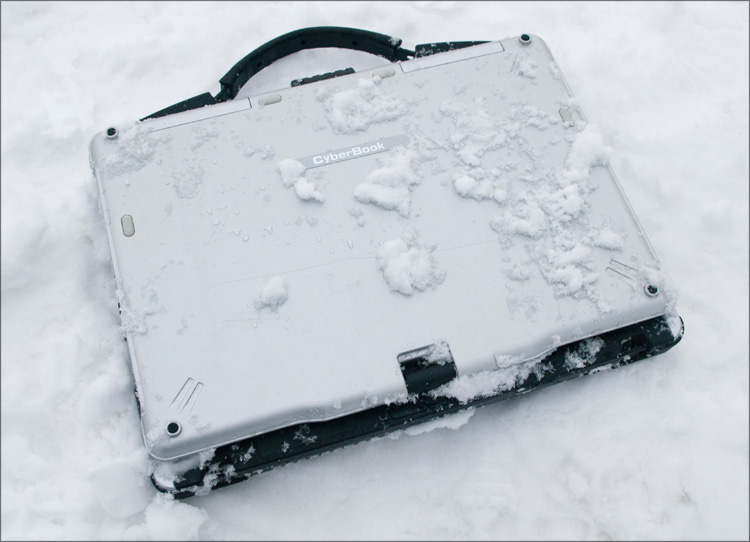
The only thing I managed to slightly scratch the lid of the laptop was a sharp screwdriver.
As they say, it's better to see once:
How else could you check the stability of the laptop to external stimuli? Frost, cold, fire and copper pipe on the screen? ) We didn’t invent anything else - if such a crash test was passed, then the notebook’s daily use will not fail. And maybe even protect;)
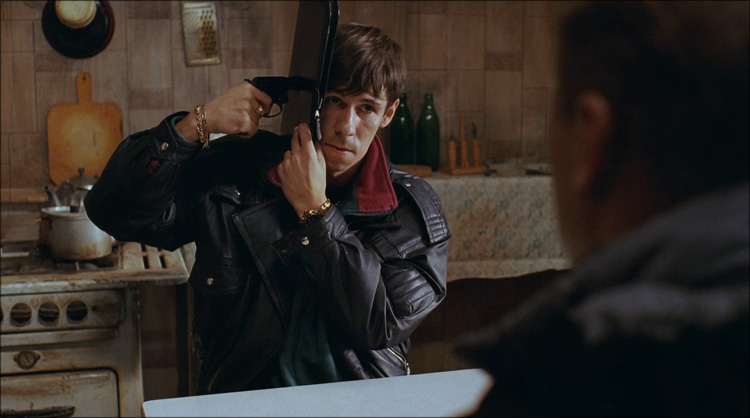
 Autopsy revealed
Autopsy revealed
After all the tests, the laptop was still alive, moreover, there were practically no scratches on it ... but something did happen. When I arrived home, the device simply refused to turn on - at that moment it even became somehow embarrassing) But it was reassuring that the laptop passed all tests unharmed, which means that nothing serious should happen. First of all, I put it on charge, because during the tests I managed to completely discharge the battery - by connecting the device to the network, the charge LED on it turned on, which inspired optimism ... but the laptop still did not turn on. Then I concluded that the whole problem is because of the snow that got inside, which melted and does not allow the machine to start. Armed with a screwdriver and a can of compressed air, I proceeded to open the patient.


The first thing turned off the power, pulled out the battery. I removed the covers of all the system compartments - inside there were really droplets of water that had been removed by a pair of “pshikov” ... but the electronics behind the ventilation system simply could not get through, so I had to disassemble everything. And that's what was learned during the showdown:
 The handle "goes" into the rubber corners, where it holds on to fairly thick but plastic protrusions; and the handle itself in this joint is also plastic, albeit from a quality material. This means that with a very strong (VERY strong) jerk, there is every chance of snatching the handle. Now I am writing this paragraph, and I involuntarily recall a case from school, when a friend started spinning his suitcase, the handle of which could not stand the centrifugal force) The result - the handle from the suitcase in hand, and the suitcase, breaking two huge glasses, flew out into the street.
The handle "goes" into the rubber corners, where it holds on to fairly thick but plastic protrusions; and the handle itself in this joint is also plastic, albeit from a quality material. This means that with a very strong (VERY strong) jerk, there is every chance of snatching the handle. Now I am writing this paragraph, and I involuntarily recall a case from school, when a friend started spinning his suitcase, the handle of which could not stand the centrifugal force) The result - the handle from the suitcase in hand, and the suitcase, breaking two huge glasses, flew out into the street.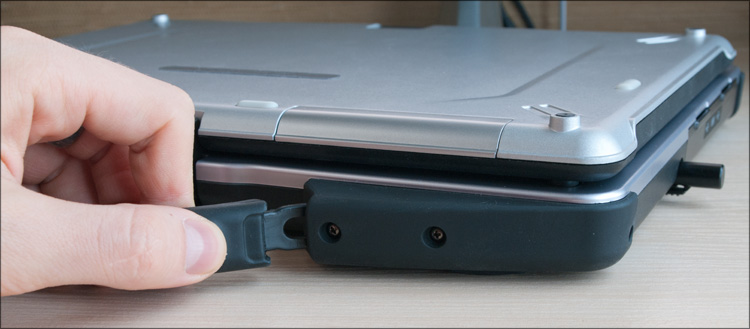
 Under the keyboard is a kind of pallet, also made of metal. This pallet covers the entire surface and in one of the places has a hole - just the one through which the water goes (through the bottom). This means that it was possible to pour at least a ton of water on the keyboard and touchpad - nothing would have happened with the laptop. The same pallet adds mechanical strength to the notebook - I am almost sure that the keyboard (without prejudice to the stuffing) could be stepped on or even hit.
Under the keyboard is a kind of pallet, also made of metal. This pallet covers the entire surface and in one of the places has a hole - just the one through which the water goes (through the bottom). This means that it was possible to pour at least a ton of water on the keyboard and touchpad - nothing would have happened with the laptop. The same pallet adds mechanical strength to the notebook - I am almost sure that the keyboard (without prejudice to the stuffing) could be stepped on or even hit.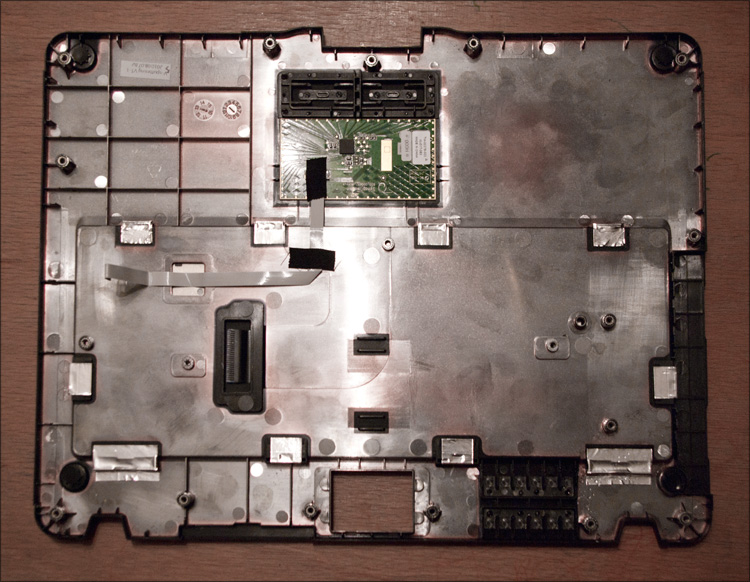
 In addition to insulated wires for video transmission, the screen goes to wires from wireless communication modules (usually antennas always go around the perimeter of the display) - all this is well protected from moisture by two metal cylinders of different diameters (one in the laptop case, the other in a hinge mount) which eliminates the ingress of water. But much more I was pleased with the very fastening of the screen to the body - solid metal parts, a large number of screws ... it’s just that the screen will not fall off for sure - if you just “accidentally” pull out “with meat”. Bravo.
In addition to insulated wires for video transmission, the screen goes to wires from wireless communication modules (usually antennas always go around the perimeter of the display) - all this is well protected from moisture by two metal cylinders of different diameters (one in the laptop case, the other in a hinge mount) which eliminates the ingress of water. But much more I was pleased with the very fastening of the screen to the body - solid metal parts, a large number of screws ... it’s just that the screen will not fall off for sure - if you just “accidentally” pull out “with meat”. Bravo.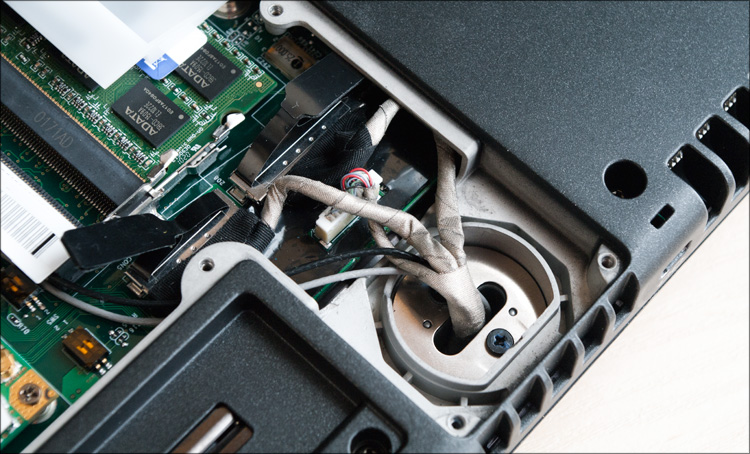

 I accidentally noticed that for the “tablet” state all the LEDs were duplicated.
I accidentally noticed that for the “tablet” state all the LEDs were duplicated.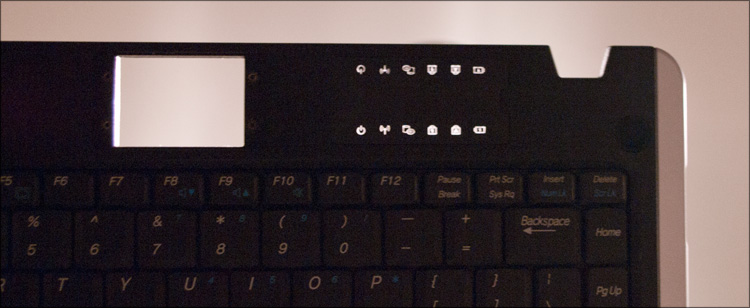
 Under the keyboard "tray" is all the electronics - to be honest, I expected to see much more) And there is only one large board of complex shape, a couple of loops and soldered microcircuits (including the processor from which the heat pipe goes to the ventilation system). All electronics are covered with a thin and flexible plastic sheet that is glued to the board around the perimeter. So getting moisture inside is really not that easy!
Under the keyboard "tray" is all the electronics - to be honest, I expected to see much more) And there is only one large board of complex shape, a couple of loops and soldered microcircuits (including the processor from which the heat pipe goes to the ventilation system). All electronics are covered with a thin and flexible plastic sheet that is glued to the board around the perimeter. So getting moisture inside is really not that easy!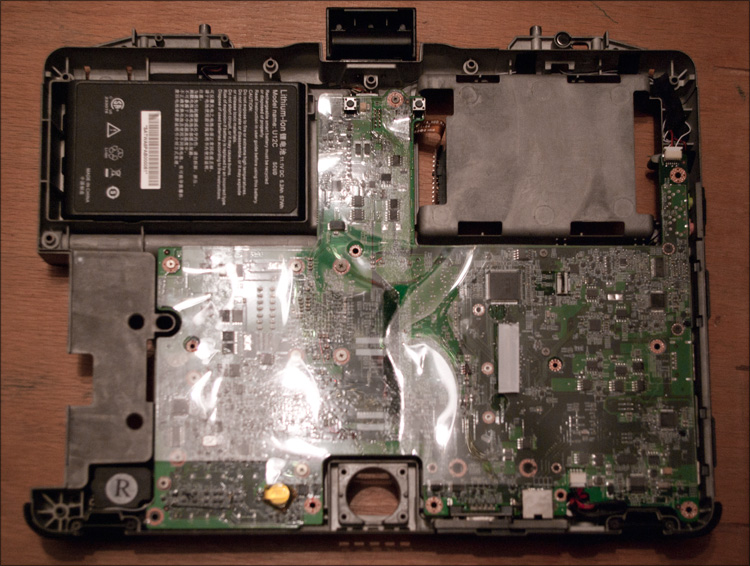
However, it still got. And as it is easy to guess, through the ventilation system, it is she who is in this laptop “Achilles heel” and it was in her area that I saw water droplets. It took a couple of minutes to thoroughly blow the entire system “from the inside” with compressed air, after which I tried (in a disassembled state) to turn on the laptop. Hurray, he earned. I started assembling a laptop, concluding that a laptop is no good except as a paddle - they can row, but then they will have to look for compressed air;) It’s hardly possible to recycle the ventilation system - only use passive cooling ( due to direct contact of the radiator with the body), but this is most likely possible only with even less efficient iron.
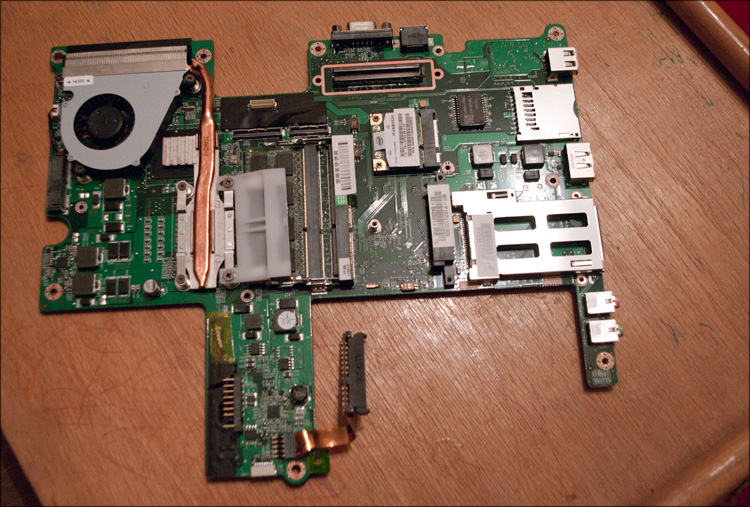
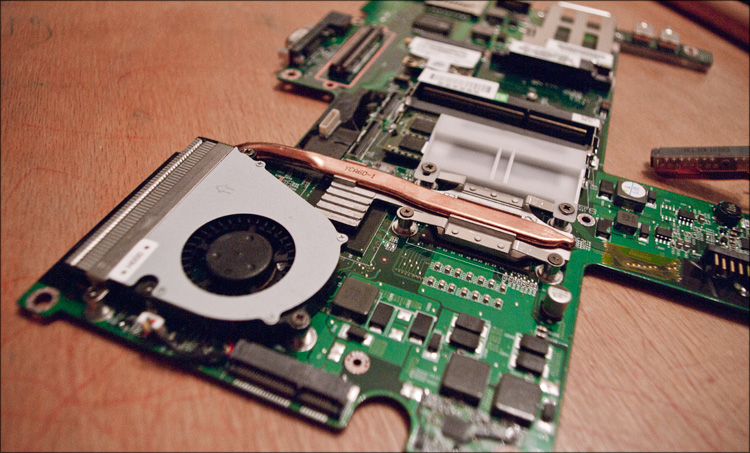
Honestly, I never took DESTEN seriously before, although I almost never came across it ... But this device radically changed my attitude towards this company. And even if they don’t make these laptops themselves, the OEM source was chosen extremely well.
Technical characteristics of DESTEN CyberBook U872
 Processor : Intel Core i3-330M (two cores, 2.13 GHz, 3 MB L3, 32 nm, TDP 35 W, Intel 64)
Processor : Intel Core i3-330M (two cores, 2.13 GHz, 3 MB L3, 32 nm, TDP 35 W, Intel 64)Chipset : Intel HM55
Graphics subsystem : Intel HD Graphics
RAM : 2048 MB, DDR3 PC3-10700 (667 MHz), two slots
Data Storage : 250 GB 2.5 '' Western Digital Hard Drive
Operating system : Microsoft Windows 7
Display : 12.1 ", 1280x800 (WXGA, 16:10), matte, touch (resistive), swivel
Drive : not available
Connectors : 4xUSB (2.0; one of the ports combined with eSATA), VGA, COM, RJ-45, ExpressCard 34, headphone and microphone jacks.
Wireless interfaces : Bluetooth 2.1 + EDR, Wi-Fi; GPS or HSDPA / EVDO module (optional)
Card reader : MMC / SD (SDHC)
Camera : 2 MP
Optional : shockproof, dustproof and waterproof case, keyboard, touchpad and fingerprint scanner (protection class - IP54); Smartcard (optional)
Body Material : Magnesium Alloy
Operating temperature : -20 ° C ~ 50 ° C
Battery : Li-Ion (6 cells, ~ 4 hours)
Dimensions : 328 x 277 x 40.8 mm
Weight : 2.5 kg
Price : from 80 000 rubles

Despite the fact that this laptop can easily be used by anyone, the manufacturer positions it in the following areas: rapid response services, armed forces, Emergencies Ministry, logistics services, health care, transportation, government agencies and education.
 Advantages and disadvantages
Advantages and disadvantages
 Pleasant appearance, excellent build quality
Pleasant appearance, excellent build quality Metal case, thoughtful design inside and outside
Metal case, thoughtful design inside and outside Excellent protective properties - repeatedly personally verified
Excellent protective properties - repeatedly personally verified A good range of connectors, modular system, optional GPS
A good range of connectors, modular system, optional GPS Touch swivel screen, the ability to use a laptop as a tablet
Touch swivel screen, the ability to use a laptop as a tablet Low battery life (~ 4 hours)
Low battery life (~ 4 hours) Not very high performance
Not very high performance High price
High priceThe end
Now laptops have become so accessible that sometimes the user neglects the safety precautions when working on them - someone likes to eat over the keyboard, and someone likes to drink; for someone in the order of things, put a laptop by the bed before bedtime, and in the morning accidentally stand on it. Some believe that the laptop can be thrown neatly on the sofa, hoping that it will not spring back. Manufacturers use it differently - some prefer to sell more, others know about many weak points and offer more practical solutions for higher prices. various “anti-fool” and simply means to extend the life of “machines” are used.The laptop from the review is the extreme of the second option, where the manufacturer really tried conscientiously - the test results exceeded all my expectations! It would be like to go to some "Battle psychics" and personally wonder what all these strange people do not lie :)
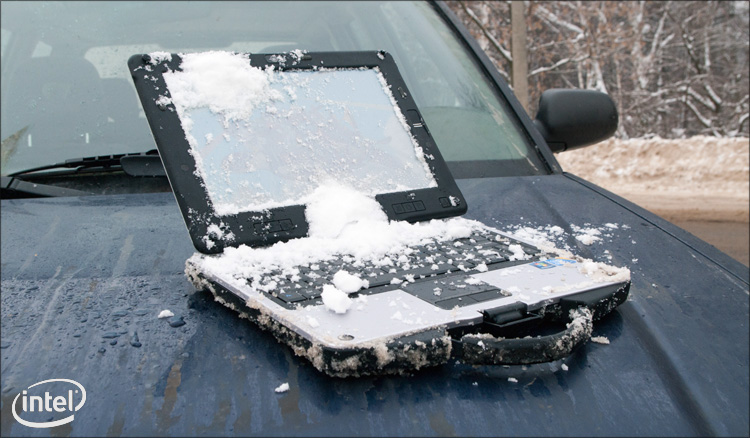
I agree, came out not very low cost, which is why only at this stage, many lose interest - because of the same money is quite possible to buy 3-4 ordinary (“flooded”) laptops of the same performance ... But I want to remind once again that really high-quality things are never cheap. Yes, and no one forces anyone to buy - fasting, rather, for general development ... someone has to do reviews of such devices, otherwise many will only guess about their existence, and doubt about the properties;)
Thanks to the couple in love for the Forester and help with the crash test, Sawyer for editing the video, Vadaboom for helping with Photoshop and Uncle Seryozha for Bernese Sennenhund)
Successes!
Source: https://habr.com/ru/post/112608/
All Articles